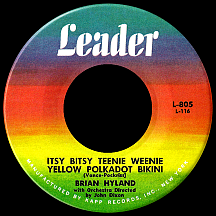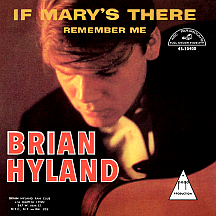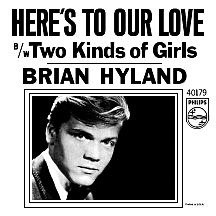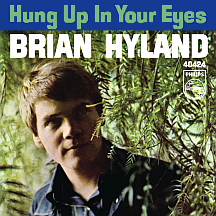BRIAN HYLAND
The bikini, a post-World War II swimsuit originating in France and named after the Bikini Atoll in the Pacific Ocean's Marshall Islands, the mid-1940s site of nuclear bomb tests (designer Louis Réard used the name for the two-piece garment in anticipation of its "explosive" success), wasn't immediately popular in the United States. While a high percentage of the population initially objected to its scanty design, acceptance was more widespread by the late '50s (women found it functional, men had an altogether different reaction). In the summer of 1960, the hit song "Itsy Bitsy Teenie Weenie Yellow Polkadot Bikini" sent sales of Réard's once-daring design soaring.
The song, written by Paul Vance and Lee Pockriss ('She was afraid to come out of the locker...she was as nervous as she could be...'), became a turning point as modest female beachgoers gave in to bolder trends and loosening standards. After breaking into the business with Perry Como's 1958 million-seller "Catch a Falling Star," Vance and Pockriss had no qualms about creating novelty tunes and light, frivolous fare; the 1959 hit "What is Love?" by The Playmates was theirs, in addition to the Easter-hipster novelty "The Chick," which they recorded for Columbia as Lee and Paul. But the person who benefited most from the instantly-popular "Itsy Bitsy Bikini" was 16-year-old singer Brian Hyland, for whom the song launched a lengthy career.
Brian lived in the Woodhaven section of Queens, New York, one of seven children in his family. During high school he and some friends formed a group they called The Delfis, putting together about 50 dollars to make an audition record at Manhattan's Nola Recording Studio. In late '59, Brian took copies of the acetate to dozens of the city's record and management companies with no luck, until Maurice "Bugs" Bower, working out of bandleader Sammy Kaye's office on 5th Avenue, showed interest. Bugs gave him a chance to sing on demonstration discs of songwriters' works, out of which a finished master was made of "Rosemary," a sweet love song penned by Ruth Lane and Madeline Clare Twomey. It was sold to Dave Kapp of Kapp Records, who released it on Leader, a new subsidiary label intended for the teenage market. Larry Hall (on Strand) and Barry DeVorzon (on Columbia) each did the song as a B side, though none of the three caught on. But this debut single by Brian was enough to convince Bower, Kapp, Vance and Pockriss that he was the best candidate they'd seen and heard to do the song they were all certain would be a major hit.
The session for "Yellow Polkadot Bikini" featured backing singers Peggy Powers (Andy Williams' duet partner on "I Like Your Kind of Love" three years earlier) and Trudy Packer (she supplied the song's spoken lines: "One, two, three, four...stick around, we'll tell you more!'). The music execs were correct on their hunch that the public would go wild for the well-produced song, its release timed for the start of summer 1960. Rising quickly on the charts throughout July, it reached number one in mid-August, the peak time for hot weather oceanfront parties (or fantasizing about such, for those who didn't have a beach nearby), while bikini sales took off. An all-girl cover by The Kittens on Alpine (with a weird, anemic-sounding guy doing the spoken part) was released to indifference; a variation, "Four Shy Girls (In Their Itsy Bitsy Teenie Weenie Yellow Polkadot Bikinis)" by The Girlfriends on Pioneer, came out the following summer...way too late! In director Billy Wilder's comedy One, Two, Three starring James Cagney, which played in theaters in late '61, a generic male vocal group disc of "Itsy Bitsy" was used to torture actor Horst Buchholz (in a funny way, of course). Foreign language covers were recorded around the globe, as custom versions dominated the charts in their own regions. "Teenie Weenie Bikini" had quite possibly become the ultimate summertime smash!
Brian was moved to the parent label; later pressings of "Bitsy Teenie" were on Kapp. The unfortunate after effect (that has stalled many a not-yet-adult singing star's career) had Hyland being handed more teen-type novelty numbers. The Vance-Pockriss follow-up, "The Clickity Clack Song Four Little Heels," lacked the pop culture "wow" factor of its predecessor and was flipped with "That's How Much," a typical teen love song contrived by Artie Kaplan, Brooks Arthur and Jack Keller. The picture sleeve touted him as "The Bikini Boy" and each side charted briefly. John D. Loudermilk's "Lop-Sided Over-Loaded (And it Wiggled When We Rode It)," about buying a car (that held 30 passengers!), borrowed heavily from the arrangement of "Yellow Polkadot." "I Gotta Go" (a Larry Kusik-E. J. Anton song) played it straight and hinted at the singer's future direction, but neither song received much exposure. Kapp was finished with Brian by early 1961; the story could have ended several months before his 18th birthday if not for rising-star songwriters Gary Geld and Peter Udell, whose ballad "Let Me Belong to You" was recorded with producer Stan Applebaum at the Bell Sound studio and sold to ABC-Paramount with help from Brian's manager, Sam Gordon. It reached the top 20 in September '61 and the label offered the singer a contract.
Geld and Udell supplied all the material for Hyland's A sides over the next three years. "Johnny Come Lately," created with a female singer in mind, was altered to "Ginny Come Lately" and had a strong top 40 run in the spring of 1962. The original version of "Sealed With a Kiss" had been unsuccessful for Columbia Records vocal group The Four Voices in 1960; a 180-degree turn from "Itsy," Brian's remake went as high as number three in July '62...another summertime smash! A country-pop sound was explored with "Warmed Over Kisses (Left Over Love)," a top 40 hit that fall. He did his own guitar playing on singles released in 1963, aesthetically pleasing numbers like "I May Not Live to See Tomorrow" ('...I may die of a broken heart tonight'), "If Mary's There" and an introspective wartime narrative, "I'm Afraid to Go Home."
He was dropped by ABC in 1964, a routine that was becoming all too familiar. Within weeks Brian began recording for Philips, a Mercury Records label, under the direction of Shelby Singleton. Udell and Geld's "Here's to Our Love" employed a '50s sound and barely registered at radio; several singles over the next two years stiffed completely. Then in 1965, "Save Your Heart For Me," one of Hyland's earlier flip sides, was a big seller for Los Angeles act Gary Lewis and the Playboys. Brian, still on Philips in '66, had begun recording in L.A. with producer Snuff Garrett and arranger Leon Russell, the same team that had helmed Lewis's string of hits. "3000 Miles," an agreeable pop tune penned by Artie Wayne, made a minor showing in April of that year, significant simply because it was Brian's first chart appearance in over two years.
Singer-songwriter Bobby Russell (who'd written Lewis's hit "Sure Gonna Miss Her") gave Brian the uptempo, radio-friendly "The Joker Went Wild," a top 20 hit in September '66. It can be considered a comeback (not his only one!) and it probably didn't hurt that "Joker" was a buzz word at the time, what with Batman the hottest show on TV in 1966. Garrett's production of "Run, Run, Look and See," a song by Marty Cooper and Ray Whitley (who composed several popular tunes for The Tams), came close to being a Gary Lewis soundalike and returned Hyland to the top 40 a couple of months later. Crickets bandmates Sonny Curtis and Glen D. Hardin contributed "Hung Up in Your Eyes" and "Holiday For Clowns" to Brian's 1967 output, but by '69 another label change was in order. He remade "Tragedy" (big for both Thomas Wayne in '59 and The Fleetwoods two years later) and "A Million to One" (the Jimmy Charles hit from '60) for Dot Records, then took a shot at another summer effort, the Al Kasha-Joel Hirschhorn song "Stay and Love Me All Summer."
Del Shannon had become friends with Brian through their mutual association with Garrett and Leon Russell; they began writing together and "Could You Dig It" resulted on the Uni label in 1970, produced by Del and sung by Hyland in a style that was just a little Shannon-esque. Then the latest comeback hit came about; The Impressions' '61 breakthrough "Gypsy Woman" was reworked for the early-'70s pop market and turned out to be Brian's biggest seller since the "Teenie Weenie" song that had gotten him rolling ten years earlier. In 1971 he had notable versions of Jackie Wilson's 1959 Motown precursor "Lonely Teardrops" and Leonard Cohen's poignant "So Long, Marianne."
Hyland has continued to perform and make occasional records for many years. A notorious novelty tune put his name on the map while determination took him the rest of the way through a hitmaking ten-year-plus period. In the 1970s, singer Kenny Rankin had a habit of publicly telling the story of how he'd declined the chance to record "Itsy Bitsy Teenie Weenie Yellow Polkadot Bikini," saying he preferred to take a serious path (for a time it was cool to bash the so-called sellout early-'60s pop artists). But I'm sure there are few who would deny that Brian Hyland is a serious artist; he simply benefited from a little teen novelty pump-priming. For awhile, at least, his was a household name while the talented but relatively obscure Rankin got the serious career he wanted, though occasional five-digit record sales would certainly have helped build his audience beyond that of a cult following.
NOTABLE SINGLES:
- Rosemary - 1960
- Itsy Bitsy Teenie Weenie Yellow Polkadot Bikini - 1960
- The Clickity Clack Song Four Little Heels /
That's How Much - 1960 - I Gotta Go ('Cause I Love You) /
Lop-Sided Over-Loaded (And it Wiggled When We Rode It) - 1960 - Let Me Belong to You - 1961
- I'll Never Stop Wanting You - 1961
- Ginny Come Lately - 1962
- Sealed With a Kiss - 1962
- Warmed Over Kisses (Left Over Love) - 1962
- I May Not Live to See Tomorrow - 1962
- If Mary's There - 1963
- I'm Afraid to Go Home /
Save Your Heart For Me - 1963 - Let Us Make Our Own Mistakes - 1963
- Here's to Our Love - 1964
- 3000 Miles - 1966
- The Joker Went Wild - 1966
- Run, Run, Look and See - 1966
- Hung Up in Your Eyes - 1967
- Holiday for Clowns - 1967
- Get the Message - 1967
- Tragedy - 1969
- A Million to One - 1969
- Stay and Love Me All Summer - 1969
- Could You Dig It - 1970
- Gypsy Woman - 1970
- Lonely Teardrops - 1971
- So Long, Marianne - 1971





